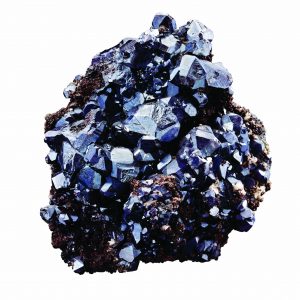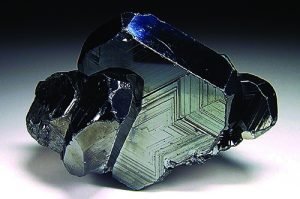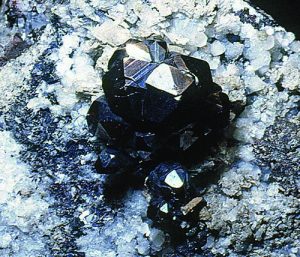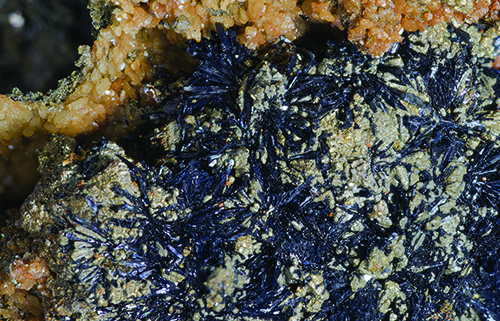
By Bob Jones
Collecting minerals and reading about them makes you realize there is an odd and sometimes confusing assortment of mineral names that do not seem logical.
Mineral names cover a fantastic variety of categories, including locality names like bisbeeite, surface features like vesuvianite, connections to people like bobjonesite, and elements like gold or cuprite. Add to that mineral named for their geometric form, like tetrahedrite, or color, like pyrargyrite from two Greek words ‘pyr’-fire and ‘argyros’-silver. Minerals are even named using their own chemical element symbols and names like cavansite — CAlcium VANadium SIlicate. We also have a host of mineral names derived from foreign languages like mimetite from the Greece “mimetes.” There really doesn’t seem to be any orderliness to how minerals are named, but as we’ll see, there are guidelines that reveal the logic behind the naming convention.
When I began looking into this confusion, I came across a wonderful old article about mineral names written in 1929. It originally appeared in the American Mineralogist and is now on the internet. In the article, the author talked about all the known minerals of the time, all 1,500. Imagine that! In less than 100 years, through diligent collecting and research, we have reached an impressive total of around 5,000 known mineral species, and the list continues to grow.
One thing that has caused confusion is that some naming structures began long before we understood their chemistry or had the English language. Names like aurum-gold, argentum-silver, plumbum-lead, mercury-hydargyrum, and ferrum-iron, are still with us. Yet, all of these elements were known long ago, and we continue to use their ancient names for the chemical symbols. We name most elements by their modern names now, but the old symbols are used even in chemical names, such as ferric oxide or ferrous oxide, or argentite for silver sulfide.
Following the Path of Naming Conventions
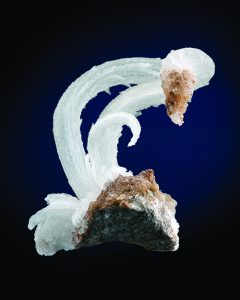
Bob Jones
It is important we have some understanding of how we arrived at today’s assortment of mineral naming methods. You may not realize that the word “mineral” was not even part of the language used to talk about these natural inorganic compounds we collected, until about 400 years ago. Consider the superb and very valuable early textbooks written by Agrocola, i.e. Georg Bauer, published in the mid-1500s. Until Agricola published these books, the art and skills of mining were a closely guarded miner’s secret. Bauer’s books were not even published until after he died. The books he authored were the first essential texts revealing all the secrets of mining, mining equipment, mining methods, and the sought-after metal ores and minerals. In fact, it revealed how to extract and process ores. No wonder Bauer waited until he was dead before allowing this book full of secrets to be available to the world.
The books that tell you what those early folks thought of minerals were entitled De Re Metallica or “On the Nature of Metals” and De Natura Fossilium or “On the Nature of Fossils.” That’s right; in those days, minerals were classified as either metal or fossils. The identification of mineral came later.
It was not until the late 1600s into the 1700s that people realized minerals were distinctly different from the organic life on earth. The transition from the days of calling minerals fossils to understand they are inorganic entities that happened during this time, but even then, minerals were organized the same as all forms of life on earth. In the 1700s, life on earth was classified in a Natural History system developed by Carlos Linnaeus. He groups all objects under two main headings: botany and zoology with minerals listed under botany, which, as you know, is the study of plants. Each plant group was then subdivided into an orderly system using terms like genus, family, species, etc.
Scientists adopted minerals into this system, but over time realized they did not fit. The problem was not enough chemical information was available yet, and scientists had to use physical properties to classify minerals. Remember, this was a time when modern chemistry was just emerging, and discoveries about minerals were made almost daily. By the arrival of the 1800s, there were guiding principles in place for naming minerals. Even so, I find it surprising that it wasn’t until 1959 that an International Commission on Naming Minerals was established. No wonder confusion reigned for decades!
Emergence of Chemical Classification
By the mid-1700s, Swedish scientist Axel Cronstedt (chronstedtite) began developing a chemical classification of minerals as he realized they simply did not adapt to the Linnaeus Natural History system. Further work was being done in chemistry by other scientists, especially in Europe, so by the early 1800s, enough chemical knowledge of minerals was known for scientists to establish a basis that would lead to today’s system.
It remained in place until a scientist whose name is well known to any serious collector, James Dwight Dana of Yale, finally created a chemical system specifically designed to accommodate and bring order to the mineral world. But even Dana encountered problems early on. His first mineralogy textbook was published in 1837 and was still influenced by Natural History classifications. However, by 1854, in the third and fourth editions titled “A System of Mineralogy,” Dana transitioned from using Natural History to his chemical classification that we use today. Within his classification system, Dana grouped minerals under chemical headings such as Native Elements, Sulfides, Sulfosalts, etc. to Silicates. This is the foundation upon which all minerals are grouped and named today.
As you look through any list of minerals, you will find all sorts of names, people, places, and chemicals, among other things. Many mineral names start with the name of a metal element followed by one or more elements called non-metals, which form the mineral. These are called ionic compounds because, to form, each mineral of these components gives, accepts, or shares electrons to bond together, forming the mineral. Metal elements tend to give up electrons, so they are positively charged. Non-metals take in electrons and are negatively charged.
Delving Into Naming Conventions
When a mineral is given a name, the metal is named first, like cuprite, Cu2O, copper
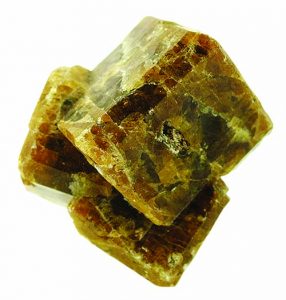
oxide. In this case, two copper atoms give up one electron to satisfy oxygen’s need for two electrons. With one atom of oxygen in the cuprite molecule, the ending -ite has been added. Aluminum oxide, lead oxide, iron oxide, and other simple oxides work the same way. This technique is used to name minerals by indicating their chemistry, so we use ite, ide ate, and so on, and each denotes something of the chemistry of the mineral. You can check the internet for the methods used with these symbols.
While -ite is added to indicate a mineral with oxygen -ide is added to mineral compounds to indicate that sulfur, not oxygen is the non-metal. Check Dana’s listing of sulfides, and you’ll see this suffix in full use. When oxygen does show up, as in anhydrite and calcium sulfate, the suffix -ate indicates oxygen along with sulfur. Anhydrite is calcium sulfate, but its name is made up of a prefix “an,” which means “no,” and the suffix “hydro” which means water. This distinguishes anhydrite from gypsum, which is the same chemistry as calcium sulfate PLUS water, so gypsum is hydrate calcium sulfate. The prefix or suffix hydrous or hydrate is used to indicate water is part of the mineral’s chemical structure. Bobjonesite is hydrous vanadium sulfate.
The above examples of naming are all tied to mineral chemistry. The overall explanation of this is far more extensive than is explained here. Spend some time researching aspects of chemistry and mineral names. I’m confident you’ll find it interesting, and it will help you understand why many minerals sport the names they do.
Two other mineral naming categories that are much simpler to understand are names of localities and people. Initially, minerals named for people were used to recognize scientists and researchers who had made important contributions to science. Sometimes the names mean little to the average collectors, like hauynite, for example. It is interesting to look up the people they are named, to see what contribution they made that brought us to today’s mineral science and hobby. In the case of Hauy, he is recognized as the father of crystallography. How about the mineral cuprosklodowskite, a lovely copper green uranium mineral named for Marie Sklodowska Curie and her work with radioactivity?
In the beginning, the practice of naming minerals after people was met with some concern. I have to admit, I used to make negative comments about using people’s names to identify a new mineral. I don’t do that anymore, now that there is a recognized bobjonesite!
Naming Minerals After Persons
In more recent years naming minerals for people has become a little more liberal. For instance, people, not necessarily scientists, have been awarded the Carnegie Mineralogical Award, which was initiated in 1987 for major contributions to the mineral science and hobby. Many have contributed literature or have made contributions to promote mineralogy education. One interesting category of this award is in recognizing organizations or magazines.
The first award in 1987 went to the Tucson Gem and Mineral Society for all they have done to bring mineral collecting in all its aspects forward. The first individual to receive the award was Dr. John Sinkankas (1988), one of my mentors. Most individuals who have received the award also have a mineral named for them. Mineralogical Record (1994) and Rocks and Minerals (1995) magazines were recognized for their contributions. Because I was awarded the Carnegie Mineralogical Award in 1998, a mineral was named for me, something I am still not sure I deserve.
The names of minerals based on a locality, mine, state, village, and such are obvious, with a few exceptions. Laurionite is a mineral named for an ancient silver mine in Greece that was producing the metal well over two thousand years ago. No matter what name is attached to a mineral, it tells you something interesting about that mineral. Whether it is a locality, a surface feature, a person, or the chemistry of the mineral itself, the more you dig into the origin of mineral names, the more you learn about our hobby and your collection.
One final word, a small text all mineral collectors should have is Fleischer’s Glossary of Mineral Species (2019). This resource is revised every few years and is an up-to-date listing of all recognized mineral species. The chemistry, crystal system, type locality, and original reference are given with each mineral. It also groups minerals related to each other. Enjoy the adventure of amassing more mineral knowledge.d
Author: Bob Jones
 Holds the Carnegie Mineralogical Award, is a member of the Rockhound Hall of Fame, and has been writing for Rock & Gem since its inception. He lectures about minerals, and has written several books and video scripts.
Holds the Carnegie Mineralogical Award, is a member of the Rockhound Hall of Fame, and has been writing for Rock & Gem since its inception. He lectures about minerals, and has written several books and video scripts.


